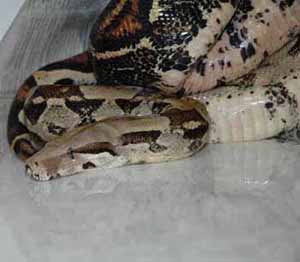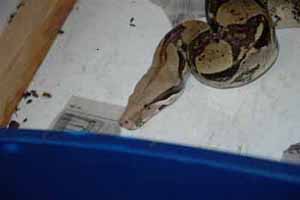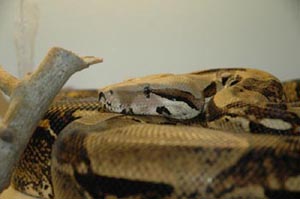Red-tail Boa Constrictor - Boa constrictor constrictor
In the wild, the red-tailed boa lives in a wide range of habitats, from high cloud forests to dry low lands. It is also frequently found near towns, where it preys on the rats and mice that often accompany populated areas. The red-tailed boa also feeds on other small mammals, amphibians, lizards, other snakes and birds. There are several subspecies of boa constrictor (species name boa constrictor) that are found in the pet trade. Red tailed boas (Boa constrictor constrictor) are commonly found in the pet trade
Before committing to ownership of a boa constrictor, be sure you will be able to handle the size and strength of a full grown snake for the 25-30 years your snake might live. A full grown boa constrictor (red tailed) will reach 8-10 feet long and weigh up to 50 pounds. These are very muscular and thick bodied snakes. While generally quite docile in temperament, it is important to respect the inherent strength of these animals and that could inflict serious injury to a person. I would consider this an advanced handler pet. Unless you have had snakes before and are committed your pets health AND have appropriate space available to cage an animal this size - do not buy one. Additionally - small dogs and cats are prey to an adult red tail boa - remember this.
DO NOT FEED WILD MICE/RATS ETC OR SUCH ANIMALS FOUND AROUND THE HOUSE – THEY MAY CARRY DISEASES AND PESTICIDES THAT COULD BE DEADLY TO YOUR PET
Average Size - The average hatchling is about 16-18 inches long, and adults can pretty easily reach 10 feet and 50+ pounds.
Life Span - On average 20 - 30 years.
Diet - Primarily rodents such as mice and rats - full grown adults can eat rabbits.
Feeding - They only need to be fed every week or two. Young snakes should be fed fuzzy mice every 5-7 days, older snakes should be fed increasingly larger prey and can go a little longer (i.e. 10 - 14 days). Use pre-killed prey as live rodents can injure a snake - dangling the prey in front of the snake with forceps usually gets the snake interested. Adults will need to feed on rats and even rabbits!
If your snake stops eating, carefully examine the husbandry, handling, health, and environment of the snake to make sure stress isn't the culprit. Consult a knowledgeable vet or experienced keeper for help if the fast is prolonged or causing weight loss. If necessary, some tricks to entice a boa to eat include dipping the prey in chicken broth, trying different colors of prey, exposing the brain of the prey before feeding it, feeding at night, covering the cage with towels after offering a mouse.
Housing - Young red tail boas (16-28 inches) will do pretty good in a ten gallon size enclosure (20x10x12 inches). A cage amounting to ¾ square foot per foot of snake is what will be needed as an adult. Shelves can and should be used to increase floor space and allow somewhere to "go" when active. A shelf also allows a warmer basking site, while forming a cooler area underneath.
Substrate - The substrate of the habitat should be easy to maintain. I have tried bark etc and frankly these snakes can crap up a storm. The best bet is just clean linoleum, plain paper or astroturf. 
Habitat - Provide a hiding place. A half-log is available at pet stores. An empty cardboard box or upside-down plastic container, both with an access doorway cut into one end, can also be used when the red tailed boa is young. The plastic is easily cleaned when necessary; the box can be tossed out when soiled and replaced with a new one. The box or log must be big enough for the snake to hide its entire body inside; if you start with a small one, you will need to eventually replace it as your snake grows. Red tail boas prefer dark places for sleeping and, as they are nocturnal, they like the dark place during our daylight hours. Place a nice climbing branch or two in the tank or cage
Temperature - . The ambient daytime air temperature throughout the enclosure must be maintained between 82-90 F, with a basking area kept at 90-95 F. At night, the ambient air temperature may be allowed to drop down no lower than 78-85 F. Special reptile heating pads that are manufactured to maintain a temperature about 20o higher than the air temperature may be used inside the enclosure. There are adhesive pads that can be stuck to the underside of a glass enclosure. You can also use incandescent light bulbs in porcelain and metal reflector hoods to provide the additional heat required for the basking area, or ceramic heating elements which can be put into regular light sockets and radiate heat downward.
Lighting - No special lighting is needed. Red tail boas are nocturnal snakes, spending their days in the wild securely hidden away from possible predators. To make it easier to see your boa during the day, you can use a full-spectrum light or low wattage incandescent bulb in the enclosure during the day. Make sure the snake cannot get into direct contact with the light bulbs.
Water - provide a dish large enough for the snake to soak in. I use the bottom of a cat litter box. Soaking is especially important during sheds. Some owners like to provide a covered dish (e.g. plastic storage container) with a hole in the lid, to provide security for the snake so it will soak longer if necessary. Another alternative is to provide a humidity retreat, which similarly uses a covered container with an access hole lined with damp sphagnum moss to provide the moisture (a water dish is still provided outside the retreat).
Recommended Supplies:
- Habitat with secure lid
- Thermometer
- Light timer
- Misting bottle
|
- Substrate
- Incandescent light or ceramic heater
- Book on boa constrictors
| Habitat Maintenance Change water daily remove droppings. Thoroughly clean the tank at least once each week: set boa aside in a secure habitat - a snake/reptile bag works well; scrub the tank and furnishings with a 3% bleach solution; rinse thoroughly with water, removing all smell of bleach; dry the tank and furnishings; and add clean substrate 
Grooming and Hygiene When cleaning housing, check boa for any abrasions, signs of parasites or or fungal infections. Always wash your hands before and after touching your snake or habitat contents to help prevent Salmonella and other infectious diseases
Captive Breeding Status - Sexing a Red tail boas is relatively easy. Like all pythons and boas, they have anal spurs. These claw-like structures are about 2" - 3" from the tip of the tail. Males have longer spurs than females. The spurs are thought to be evolutionary remnants of hind legs. Males also tend to have smaller heads than females. Mating usually requires a mild cooling or partial hibernation period. These snakes are live bearers Their gestation period can range from four to six months. The litters are large with up to 30 babies, each about 24 inches (61 cm)
Signs of a Healthy Pet:
- Clear eyes
- Clear nose and mouth
- Active and alert
|
- Eats regularly
- Healthy skin
| Common Health Issues and Red Flags:
- Vomiting
- Discharge in nose or mouth
- Lethargy
|
- Abnormal feces
- Decreased appetite
- Cloudy eyes
|
If you notice any of these signs, please contact your exotic animal veterinarian.
As with all pets in this category, it is important that you find a veterinarian that practices in EXOTICS – this is critical. The typical small animal practitioner may not have sufficient knowledge in this area. Even this guide is general in nature and should not be used to diagnose your pet.
|




